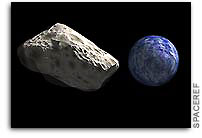100 Scientists Sign Open Letter to Support Asteroid Impact Mission

During a press event today at the Museum für Naturkunde (MfN) in Berlin, a major campaign was launched to support scientific missions designed to increase our knowledge of asteroids and near Earth objects (NEOs), in particular ESA’s Asteroid Impact Mission (AIM). The campaign, “I Support AIM,” was initiated by the co-founders of Asteroid Day, the global movement to protect the world from dangerous asteroids, and the Observatoire de la Côte D’Azur, one of the most important research institutions worldwide in the areas of biological and geological evolution and biodiversity.
During the press conference, organizers released an open letter signed by more than 100 small-body scientists supporting increased knowledge of near-Earth objects (NEOs) and space missions necessary to protect Earth from dangerous NEO impacts. The letter, now open for public signature, is available at http://www.isupportaim.com/letter
“More than 100 prominent scientists from around the world have signed a letter in support of AIM because studying NEOs cannot be under-appreciated and the AIM mission is core to gaining the knowledge we need to detect and ultimately deflect dangerous asteroids headed towards Earth,” said Grig Richters, co-founder, Asteroid Day.
NEOs are leftover matter from the formation of planets and range in size from a few meters to tens of kilometers. As with Earth, NEOs orbit the Sun and sometimes come dangerously close to Earth’s trajectory. AIM will determine whether a kinetic impactor is able to deflect such a small body, when Earth is threatened.
“New NEOs are now being discovered at the rate of some 4 per day,” said Alan Harris, senior scientist, German Aerospace Center (DLR). “We need a coordinated international strategy for near-Earth object impact mitigation!”
Within the larger AIDA international collaboration, AIM will help assess NEOS by characterizing for the first time, the small moon of a binary asteroid,” said Stephan Ulamec, Philae lander manager and AIM co-investigator (DLR): “The combined AIM and DART missions, AIDA, will give us the unique possibility to test our capabilities to deflect an asteroid, combined with fascinating science!”
AIM is a new interdisciplinary mission that is set to become humanity’s first mission to a binary asteroid system. It should launch in 2020 and is perfectly design to gather all data necessary to validate a technique called asteroid deflection. AIM will then reach the binary near-Earth asteroid (65803) Didymos in mid-2022, after an 18-month flight. There, it will wait for NASA’s DART spacecraft, which will impact the smallest of the two asteroids, in an attempt to deviate its orbit. AIM will able to carry out detailed before-and-after observations of the asteroid’s structure as well as its orbit, fully documenting the consequences of DART’s kinetic impact. This would be the first-ever attempt to deflect the orbit of a solar system body.
“We now have knowledge about the surface of comets and asteroids from space missions, including Rosetta and Dawn — and based on this experience we are best prepared for a mission on asteroid deflection,” said Holger Sierks, principal investigator Rosetta/OSIRIS, Planets and Comets Department, Max Planck Institute for Solar System Research.
“Simulations of asteroid deflection by impact are only as good as the knowledge we put into them. With AIM and DART, we have the unique opportunity to test our simulations and feed them with new knowledge about the asteroid’s responds on impact,” echoed Kai Wünnemann, Head of Division Impact and Meteorite Research at MfN
AIM will also demonstrate advanced new technologies for use in future planetary missions and also pave the way to new types of deep-space missions using CubeSats for riskier operations.
Of the NEOs so far discovered, there are more than 1700 asteroids currently considered hazardous. Unlike other natural disasters, this is one we know how to predict and potentially prevent with early discovery. As such, it is crucial to our knowledge and understanding of asteroids to determine whether a kinetic impactor is able to deflect the orbit of such a small body, in case Earth is threatened. This is what AIDA will help us assess.
The press conference was live-streamed in English and in German, and a recording can be found at http://isupportaim.com/live
Participants in the press conference:
* Grig Richters (moderator), filmmaker and Asteroid Day co-founder
* Dr. Patrick Michel, AIDA/AIM Principal Investigator, Observatoire Côte d’Azur, CNRS
* Dr. Kai Wünnemann, Head of Division Impact and Meteorite Research at MfN
* Dr. Holger Sierks, Principal Investigator Rosetta/OSIRIS, Planets and Comets, Department at Max Planck Institute for Solar System Research
* Dr. Cornelius Schalinski, Deputy Head Business Development, OHB
* Prof. Alan Harris, Senior Scientist, German Aerospace Center DLR
* Dr. Stephan Ulamec, Philae lander manager and AIM co-investigator, DLR
* Prof. Dr. Jürgen Blum, Head of Planet Formation and Small Bodies group, IGeP, TU Braunschweig
Media Contact:
Diane Murphy
+1 310.658.8756
pr@isupportaim.com
Press kit:
http://isupportaim.com/newsroom/
Interactive video featuring Stephen Hawking, Brian May, Patrick Michel, Chris Hadfield, Rusty Schweickart, Ed Lu and others: http://isupportaim.com/video/
About the Côte d’Azur Observatory
The Cote d’Azur Observatory (OCA) in Nice, France, is a public research centre for Astronomy and Earth sciences. OCA hosts three research laboratories, among them the Lagran Laboratory of CNRS (National Centre for Scientific Research), which focuses on research in instrumentation, ground/space-based observations and theoretical/numerical modeling in the fields of planetology, fluid mechanics, plasma and solar physics, and cosmology.
About Asteroid Day
Asteroid Day is a global movement to increase public awareness of potential asteroid collisions and the means to protect Earth. It was co-founded in 2015, by Dr. Brian May, astrophysicist and lead guitarist for the rock band Queen, Apollo astronaut Rusty Schweickart, and German filmmaker Grig Richters. Asteroid Day is held on 30 June each year to mark Earth’s largest asteroid impact in recorded history, the Siberia Tunguska event, which devastated over 2000 square km, the size of any major metropolitan city.









